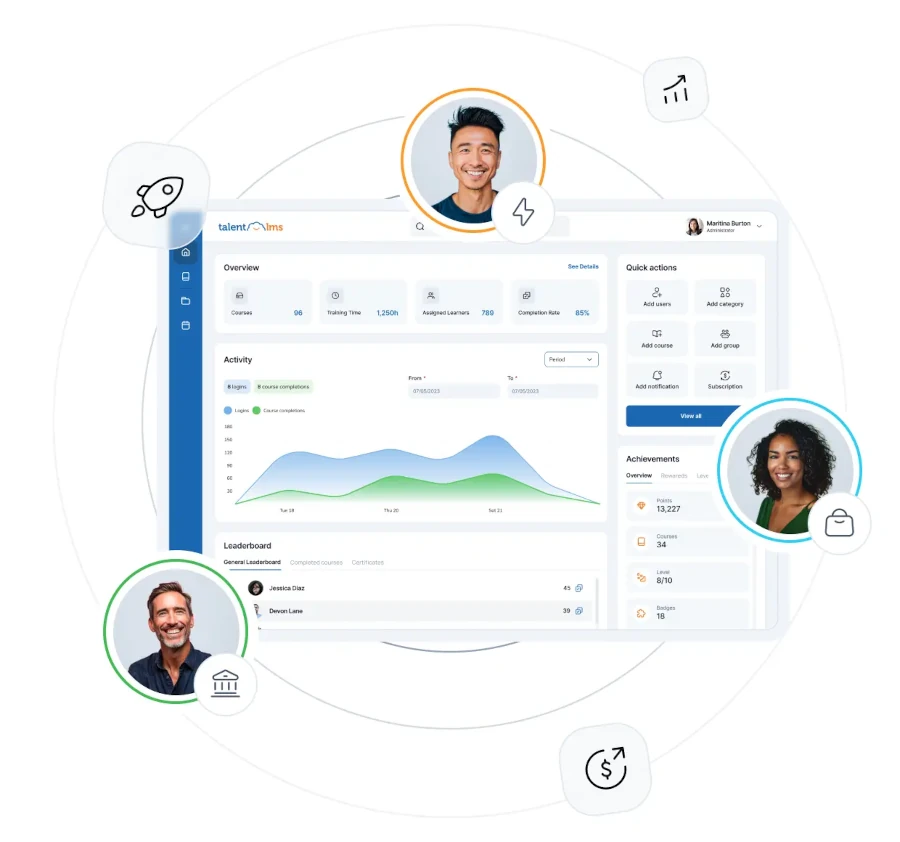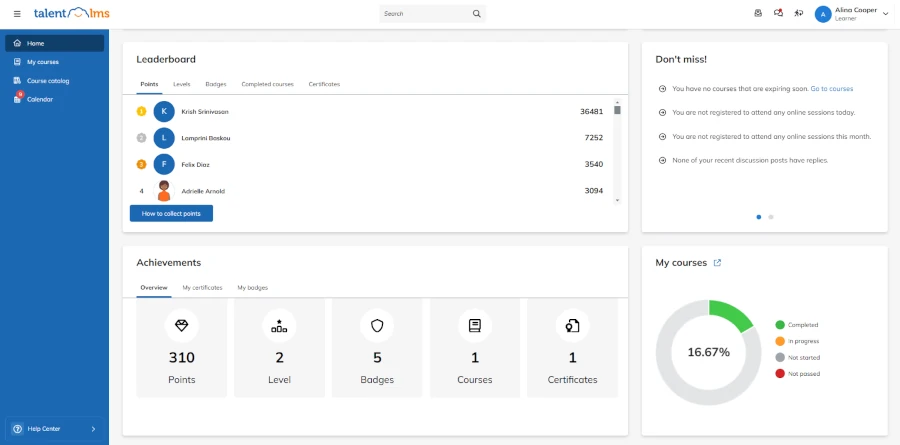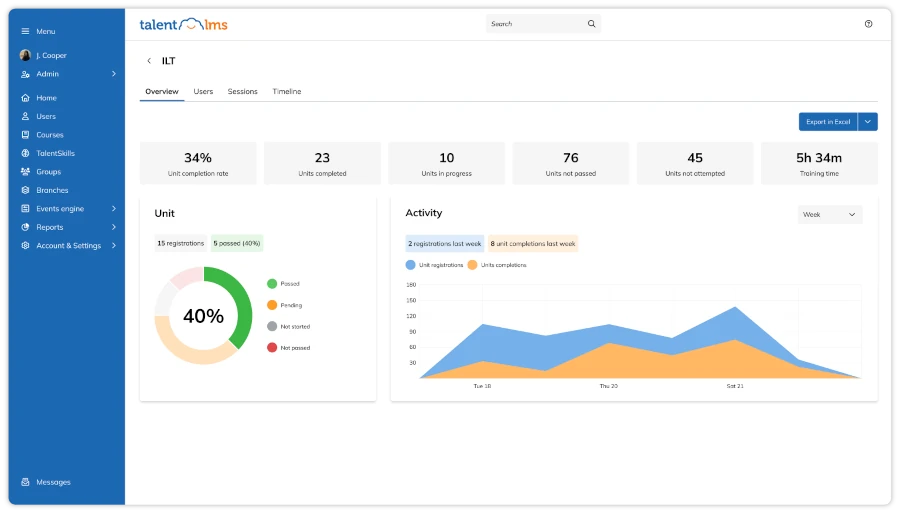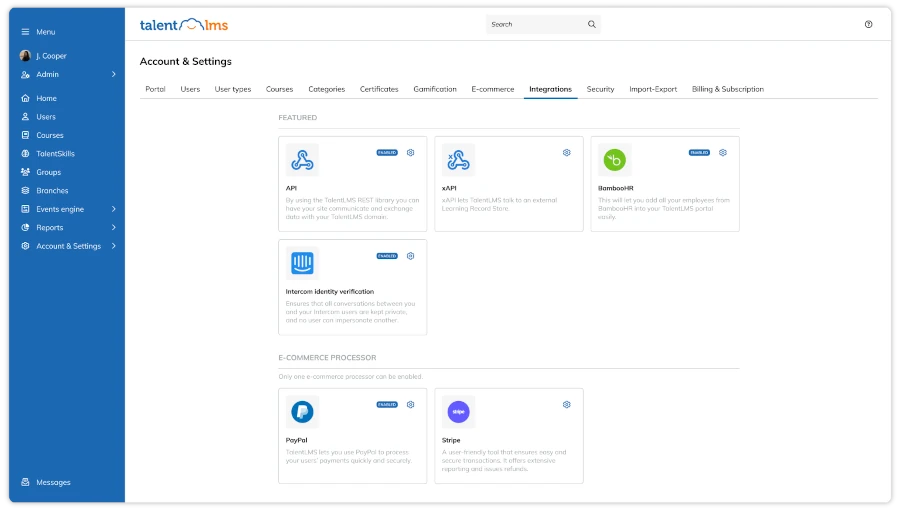Customer Training: Guide and Strategies for Successful Programs
Customer training is one of the most effective ways for organizations to keep their clients engaged. But how can you achieve this goal? The answer is clear: start by empowering them. After all, customer training goes beyond tutorials or guides. It's a powerful strategy to increase loyalty, build trust, and drive growth.
When customers know how to use your product or service, they stick around. They become your biggest advocates. And they recommend you to others.
In this article, we’ll explore everything about customer training and show how this strategy can set your business apart from the competition. Think higher retention rates, greater engagement, and stronger relationships.
Let’s get started!
What is customer training?
Customer training (also known as customer education or enablement) is any kind of training offered to customers so they can use an organization’s product or service to its fullest potential.
Help and support your customers to solve potential problems before they even face them, by offering the right training program through your customer training LMS. With customer training programs, you not only set your customers up for success but also strengthen your own business.
Customer training is not just an onboarding process.
Although onboarding is a crucial part of the customer journey, it's not the first and last stop. To bring more value to your business, think of customer training as a continuous process that spans the entire customer lifecycle.
A new customer will need different training from someone who has been using your product or service for months or years. Examples of customer training programs include onboarding, guided tutorials, webinars, and ongoing training.
For example, a project management software company might offer onboarding training to new clients, showing them how to get started. Later, that same company can provide ongoing training to keep customers up to date with new features, advanced functionalities, and various use cases.
Customer training benefits: A win for all
What are the advantages of customer training?
Customer education goes beyond simply teaching how to use your product or service. It’s about empowering your customers, improving their experience, and driving long-term success—for them and your business.
Let’s explore why offering customer training is one of the smartest decisions you can make.
Benefits for customers
Faster onboarding
With effective training, customers can start using your product quickly. They understand the value of your solution and feel confident using it, reducing frustration and hesitation. This speeds up the achievement of meaningful results and creates a positive first impression of your brand.
Better product knowledge
By offering training, companies ensure customers know how to get the most out of the product’s features. They discover solutions tailored to their needs and explore advanced functionalities that might otherwise go unnoticed. This complete understanding maximizes ROI and reinforces confidence in choosing your product.
More confidence and independence
Well-trained customers don’t need to rely on support for every question. They gain autonomy and feel empowered, leading to a smoother user experience. This independence reduces frustration, speeds up problem-solving, and gives customers a greater sense of control over their own success.
Greater success and satisfaction
When customers know how to achieve their goals with your product, they’re happier. They see your brand as a valuable partner—not just a provider. Satisfied customers are more likely to recommend your product, becoming brand advocates and fueling your business’s organic growth.
Access to continuous resources
Modern customer training programs often include on-demand resources such as tutorials, FAQs, and community forums. This allows customers to find solutions anytime, anywhere. Having access to practical resources helps them overcome challenges quickly and encourages continuous learning, keeping them engaged and loyal to your brand.
Improved decision-making
Well-trained customers make more informed decisions about how to use your product to meet their specific needs. They’re more likely to adopt features or updates aligned with their goals, ensuring long-term satisfaction.
How can effective customer training benefit a business?
Higher customer satisfaction
Your customers will be able to use your products and services efficiently and to their full potential after completing a training program. This makes their lives easier, as your product/service adds value to their daily routine. As a result, they become happier and more satisfied.
Additionally, customer education helps build confidence in using the product. This can lead customers to discover new ways of using it—even those the creators hadn’t considered—further increasing its value.
Increased customer loyalty
Customer training programs show that your company wants them to get the most out of your products and services. This gesture demonstrates professionalism and respect for the customers who support your brand. As a result, they’re more likely to stay with your company and remain loyal to your brand.
More word-of-mouth promotion
Satisfied and loyal customers become brand ambassadors, willing to leave positive reviews online or recommend your products and services. This is a reliable, low-cost, and highly effective form of advertising. Keeping your customers satisfied through well-structured training ensures they share positive experiences about your company.
More upselling opportunities
When customers have a positive experience with one of your products or services, there’s a good chance they’ll start trusting your brand as a whole. This makes them more likely to purchase new features, upgrades, or even other products and services you offer instead of turning to competitors.
Increased revenue
Profit grows with effective customer training. Satisfied and loyal customers attract more clients to your business, buy more products, services, features, and renewals. At the same time, since your training program answers common questions and helps with problem-solving, you can reduce investments in a large and costly customer support team.
Competitive market advantage
Modern companies stand out by offering robust customer training programs through a dedicated LMS platform. When customers receive personalized training based on their needs, the positive perception of your company increases significantly, strengthening your reputation in the market.
Boost your brand reputation and gain a competitive edge!
Provide robust customer training with TalentLMS, the training platform users consistently rate as #1!

Measuring the ROI of Customer Training: Unlocking Long-Term Value
Customer training is not just a tool to enhance the customer experience—it's a measurable investment that delivers tangible business results.
By reducing costs, increasing revenue, and strengthening loyalty, customer training provides undeniable financial value. Here are the key indicators you should track:
Customer retention rates
Retaining customers is much cheaper than acquiring new ones. Training helps reduce churn and strengthens loyalty by empowering customers to succeed with your product.
Example: According to Salesgenie, a 5% increase in customer retention can boost profitability by up to 95%, significantly impacting your bottom line.
Support ticket volume and resolution time
Well-trained customers resolve common issues on their own, resulting in fewer tickets and faster solutions. This not only reduces costs but also frees your support team to handle more complex issues.
Example: Companies reported a 15% reduction in support ticket volume after implementing comprehensive training programs.
Upsell and cross-sell revenue
Training encourages customers to explore advanced features and add-ons, increasing their confidence and willingness to invest more. Informed customers are more likely to upgrade or expand their use of your services.
Example: Trained customers generate 20% to 30% more upsell revenue compared to untrained users, according to Salesgenie.
CSAT (Customer Satisfaction Scores)
Training programs directly impact satisfaction by ensuring customers get the most value from your product. High CSAT scores indicate your program is generating positive experiences and building trust.
Example: Nosto, a personalization platform for e-commerce, used TalentLMS to efficiently train their employees. This strategic initiative led to exceptional revenue growth and more satisfied customers, as the team became better equipped to meet their needs.
NPS (Net Promoter Score)
Trained customers are more likely to become brand advocates, sharing positive feedback and generating referrals. This engagement lowers Customer Acquisition Costs (CAC) and drives long-term growth.
Example: Word-of-mouth marketing can reduce CAC by up to 50%, making scalability more efficient.
Scalable growth
Modern LMS platforms enable training delivery to thousands of customers at minimal additional cost. Moreover, this scalability ensures your program continues to provide value without consuming excessive resources.
Example: Scaling training for hundreds of users costs significantly less than conducting individual customer onboarding sessions.
10 Tips for Creating a Successful Customer Training Program
Now you understand the benefits of customer training and how to measure its ROI. But how do you start building a strategy that truly delivers results?
Here are 10 tips to guide you:
1. Identify and understand customer needs
Your products and services meet different demands. For example, a time-tracking tool may help businesses manage billing and project costs while helping individuals monitor hobbies or personal goals. So, tailor training to specific audiences through surveys or user interviews to ensure relevance.
2. Create clear, engaging, and flexible content
Develop training materials that suit different learning styles, such as videos, presentations, and modules. A course can include interactive elements like quizzes, gamification, and discussion forums to keep learners engaged. For quick content creation, tools like TalentCraft—your AI-powered course content generator—can help build complete modules in no time.
3. Personalize the learning experience
Not all customers learn the same way or at the same pace. Personalize training with customizable learning paths, self-assessments, and mobile learning options. Use features like automated notifications to keep learners on track by sending reminders, feedback, or new materials.
4. Promote collaboration and community engagement
Active learning thrives in collaborative environments. So, use discussion forums for customer interaction, integrate webinars, and host live Q&A sessions. These resources not only support learning but also create a sense of community around your product or service.
5. Leverage data-driven insights
Monitor training performance using analytics. Track metrics such as course completion rates, skill development, and customer satisfaction levels. Also, use these insights to improve your approach, ensuring content evolves to meet customer needs.
6. Ensure accessibility for all
Make your training programs accessible by adopting mobile-compatible platforms and inclusive features like captions, text-to-speech tools, and intuitive navigation for users with varying skill levels.
7. Keep content updated and relevant
Regularly update training materials to reflect new product features, industry trends, and customer feedback.
8. Use feedback for improvements
Collect feedback through surveys, polls, or direct conversations to assess training effectiveness. Then, act on this feedback to fix weak points and highlight successes.
9. Celebrate customer achievements
Acknowledge customer milestones by awarding badges, certificates, or public recognition. Certifications can boost professional credibility and demonstrate your commitment to customer growth.
10. Provide ongoing support and additional resources
Offer continuous support materials such as user guides, webinars, and a support portal so customers can maximize training value even after completing the course.
What Topics Should Customer Training Include?
For your customer training to be effective and complete, it's essential to cover all the relevant topics they need.
Here are the key topics that should be part of your customer training LMS:
Product knowledge training
Help your customers better understand your product or service with a product knowledge-focused training. Offer training materials in your LMS that cover the following aspects of your product: product introduction, main features, solutions, use cases, and key benefits.
Customer onboarding training
During onboarding and implementation training, customers learn how to set up and use your product or service. This process includes everything—from signup steps and activation to first-time use. Right from the start, customers see value by feeling confident in a fully guided environment.
Customer support and troubleshooting
It’s inevitable that your customers will have questions when using your product or service. That’s why you should use your training LMS to conduct surveys and identify the main challenges your customers face. Then, create materials with frequently asked questions (FAQs) and common issues, in collaboration with your customer support team.
Industry-specific training
Generic training may not be enough to meet customer needs. Each industry has its own standards, best practices, and trends. Make your training more relevant by connecting your product/service to the specific demands of your customers’ industries. Teach them how to best apply your technologies and methods within their sector context.
Why you should use an LMS for customer training
An LMS is a powerful tool to enhance your customer training strategy, making learning simpler, more engaging, and more effective.
Here’s how an LMS can transform your training:
Intuitive design for hassle-free learning
Customers need a platform that doesn’t get in the way of their learning experience. An intuitive and user-friendly LMS, like TalentLMS, ensures a smooth experience from login to course completion. Its modern interface and responsive design remove technical barriers, allowing customers to focus on learning instead of usability. This is especially important for non-technical users, ensuring accessibility across all customer segments.
Efficient support for onboarding
Onboarding is a critical stage in the customer journey. An LMS simplifies guiding new customers through account setup, activation, and first-time use. Interactive modules, videos, and step-by-step guides make the process clear and stress-free. A well-structured onboarding experience builds confidence and ensures customers start using your product successfully from day one.
Customizable and versatile content delivery
An LMS allows you to deliver content in various formats to meet different learning preferences—such as videos, infographics, quizzes, and text. Some customers may prefer video demos to quickly solve issues, while others may benefit from manuals to explore advanced features. This flexibility ensures personalized training aligned with diverse audience needs.
Greater engagement with dynamic features
Traditional, monotonous training is a thing of the past. With an LMS, you can create interactive and engaging experiences using gamification, scenario-based learning, and microlearning. For example, you can implement leaderboards, reward systems, or even simulated environments where customers practice using your product in real-world situations. These features increase knowledge retention and motivate customers to keep learning.

Learning anytime, anywhere
With mobile compatibility, your LMS offers flexibility so customers can learn whenever it’s most convenient for them—whether in the office, on the go, or on-site while using your product. This accessibility is especially valuable for global clients in different time zones or for industries that require just-in-time learning, such as field services and healthcare.
Scalable training for growing businesses
As your customer base grows, managing training manually can become a challenge. An LMS facilitates scalability by automating processes like course assignment, reminders, and updates. Whether you’re training 10 or 10,000 customers, your LMS ensures consistent delivery and quality, saving time and resources. In other words, it’s an essential strategy for those who need to grow!
Data-driven insights for continuous improvement
Data is essential for an effective training program. TalentLMS provides detailed reports and dashboards to monitor learner participation, course completion rates, and skill gaps. These insights help you identify trends, optimize content, and measure the impact of training on customer satisfaction and business goals. Plus, with reporting tools, you can calculate training ROI and demonstrate its value to stakeholders.

Cost-effectiveness and ROI
Traditional training methods, such as in-person workshops, can be expensive and resource-heavy. That’s why an LMS offers a more cost-effective alternative, eliminating expenses with travel, venue rental, and printed materials. This allows you to reallocate resources toward developing richer, more impactful content.
Monetization support
An LMS doesn’t just train customers—it can also generate revenue. Does your training content offer value beyond your current customer base? Then you can monetize it by offering paid courses. E-commerce features integrated into TalentLMS let you manage transactions, adding a new layer of profitability to your online training programs.

Faster adaptation to change
Today, agility is key. An LMS enables you to quickly update or launch new training content in response to product updates, customer feedback, or market trends. For instance, if a new feature is released, you can immediately make the corresponding training module available to ensure customers know how to use it effectively.
Stronger customer loyalty and advocacy
A well-structured LMS strengthens long-term relationships by showing your commitment to customer success. Customers who see this investment in their learning and growth are more likely to stay loyal and recommend your brand. Additionally, by earning certifications through your LMS, they can share their achievements on social media, expanding your brand’s visibility and reputation.
Empower Your Business with Customer Training
Customer training helps create brand advocates, strengthen loyalty, and drive measurable growth. In other words, when companies invest in their customers’ success, they invest in their own growth.
With an LMS, you simplify learning, track results, and adapt quickly to change. Companies that prioritize customer training gain real benefits such as lower churn, higher satisfaction, and increased upsell revenue.
Customers expect more than just a product—they seek a partner in their journey. Become that partner and reap the rewards of that relationship. Now is the time to lead the way!
Article Author:
Elena Koumparaki – Content Writer
Elena combines real-world data and storytelling to create impactful content on L&D and HR. Always on trend, her engaging work addresses today’s needs.
Link to the original English article: https://www.talentlms.com/blog/customer-training/
Images adapted by GuiaLMS via Freepik











Leave a comment